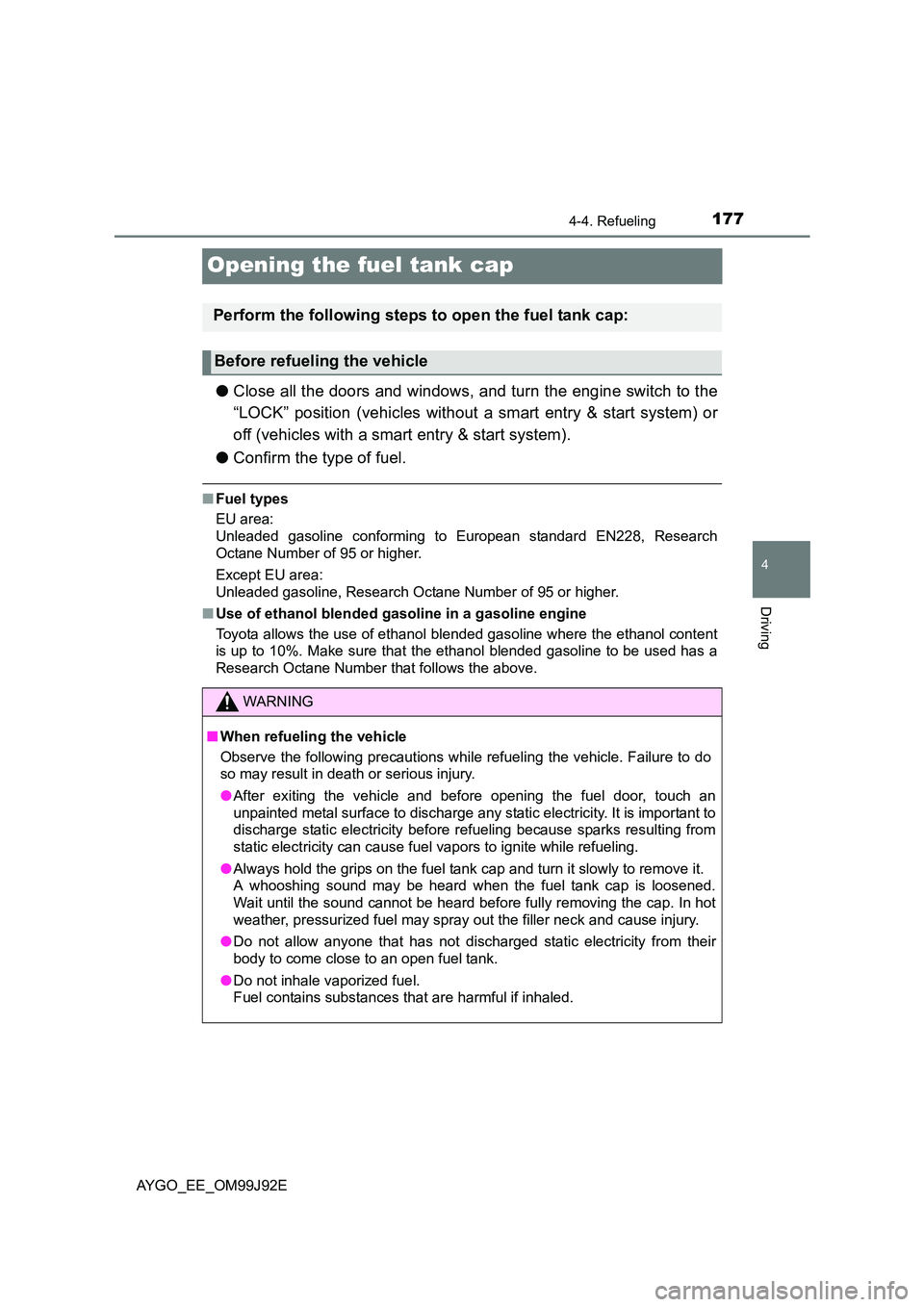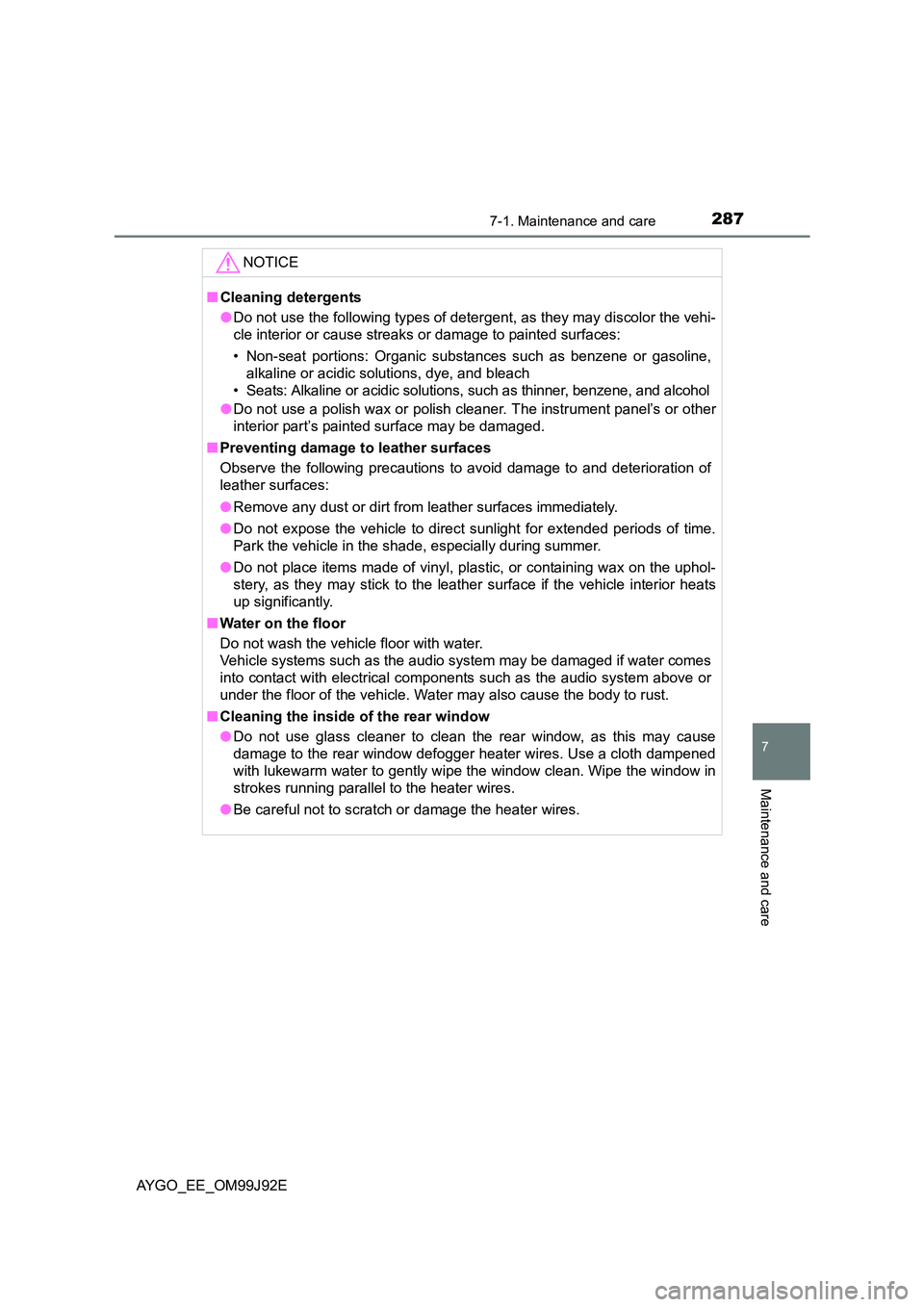Page 177 of 440

177
4
4-4. Refueling
Driving
AYGO_EE_OM99J92E
Opening the fuel tank cap
●Close all the doors and windows, and turn the engine switch to the
“LOCK” position (vehicles without a smart entry & start system) or
off (vehicles with a smart entry & start system).
● Confirm the type of fuel.
■Fuel types
EU area:
Unleaded gasoline conforming to European standard EN228, Research
Octane Number of 95 or higher.
Except EU area:
Unleaded gasoline, Research Octane Number of 95 or higher.
■ Use of ethanol blended gasoline in a gasoline engine
Toyota allows the use of ethanol blended gasoline where the ethanol content
is up to 10%. Make sure that the ethanol blended gasoline to be used has a
Research Octane Number that follows the above.
Perform the following steps to open the fuel tank cap:
Before refueling the vehicle
WARNING
■ When refueling the vehicle
Observe the following precautions while refueling the vehicle. Failure to do
so may result in death or serious injury.
● After exiting the vehicle and before opening the fuel door, touch an
unpainted metal surface to discharge any static electricity. It is important to
discharge static electricity before refueling because sparks resulting from
static electricity can cause fuel vapors to ignite while refueling.
● Always hold the grips on the fuel tank cap and turn it slowly to remove it.
A whooshing sound may be heard when the fuel tank cap is loosened.
Wait until the sound cannot be heard before fully removing the cap. In hot
weather, pressurized fuel may spray out the filler neck and cause injury.
● Do not allow anyone that has not discharged static electricity from their
body to come close to an open fuel tank.
● Do not inhale vaporized fuel.
Fuel contains substances that are harmful if inhaled.
Page 189 of 440

1894-5. Using the driving support systems
4
Driving
AYGO_EE_OM99J92E
■ If the Stop & Start cancel indicator continues to flash
The Stop & Start system may be malfunctioning. Contact any authorized
Toyota dealer or repairer, or another duly qualified and equipped professional.
■ If the windshield is fogged up while the engine is stopped by the Stop &
Start system
● Vehicles with a manual air conditioning system: Restart the engine by
depressing the clutch pedal ( →P. 185) or by pressing the Stop & Start can-
cel switch, and then set the air outlet selection dial to . ( →P. 258)
● Vehicles with an automatic air conditioning system: Turn the windshield
defogger on. (The engine will start due to the automatic engine start func-
tion.) ( →P. 264)
If the windshield fogs up frequently, press the Stop & Start cancel switch to
deactivate the system.
■ The Stop & Start system operation time and Stop & Start system total
operation time display
→ P. 8 6
■ Replacing battery
The installed battery is specific to the Stop & Start system. It should only be
replaced with a battery of identical type and rating.
Ask any authorized Toyota dealer or repairer, or another duly qualified and
equipped professional for further details.
WARNING
■ When the Stop & Start system is operating
● Keep the shift lever in N and apply the brake pedal or parking brake for
safety while the engine is stopped due to the Stop & Start system (while
the Stop & Start indicator is on).
Unexpected accidents may occur due to the automatic engine start func-
tion.
● Do not leave the vehicle while the engine is stopped due to the Stop &
Start system (while the Stop & Start indicator is on).
Unexpected accidents may occur due to the automatic engine start func-
tion.
● Ensure that the engine is not stopped by the Stop & Start system while the
vehicle is in a poorly ventilated area. The engine may restart due to the
automatic engine start function, causing exhaust gases to collect and
enter the vehicle and resulting in death or a serious health hazard.
Page 287 of 440

2877-1. Maintenance and care
7
Maintenance and care
AYGO_EE_OM99J92E
NOTICE
■ Cleaning detergents
● Do not use the following types of detergent, as they may discolor the vehi-
cle interior or cause streaks or damage to painted surfaces:
• Non-seat portions: Organic substances such as benzene or gasoline,
alkaline or acidic solutions, dye, and bleach
• Seats: Alkaline or acidic solutions, such as thinner, benzene, and alcohol
● Do not use a polish wax or polish cleaner. The instrument panel’s or other
interior part’s painted surface may be damaged.
■ Preventing damage to leather surfaces
Observe the following precautions to avoid damage to and deterioration of
leather surfaces:
● Remove any dust or dirt from leather surfaces immediately.
● Do not expose the vehicle to direct sunlight for extended periods of time.
Park the vehicle in the shade, especially during summer.
● Do not place items made of vinyl, plastic, or containing wax on the uphol-
stery, as they may stick to the leather surface if the vehicle interior heats
up significantly.
■ Water on the floor
Do not wash the vehicle floor with water.
Vehicle systems such as the audio system may be damaged if water comes
into contact with electrical components such as the audio system above or
under the floor of the vehicle. Water may also cause the body to rust.
■ Cleaning the inside of the rear window
● Do not use glass cleaner to clean the rear window, as this may cause
damage to the rear window defogger heater wires. Use a cloth dampened
with lukewarm water to gently wipe the window clean. Wipe the window in
strokes running parallel to the heater wires.
● Be careful not to scratch or damage the heater wires.
Page 408 of 440
4089-1. Specifications
AYGO_EE_OM99J92E
�X1KR engine
*: The engine oil capacity is a reference quantity to be used when changing
the engine oil. Warm up and turn off the engine, wait more than 5 minutes,
and check the oil level on the dipstick.
Fuel
Fuel type
EU area:
Unleaded gasoline conforming to European stan-
dard EN228 only
Except EU area:
Unleaded gasoline only
Research octane
number95 or higher
Fuel tank capacity
(Reference)35 L (9.2 gal., 7.7 Imp.gal.)
Lubrication system
Oil capacity
(Drain and refill Reference*)
With filter2.8 L (3.0 qt., 2.5 Imp.qt.)
Without filter2.6 L (2.7 qt., 2.3 Imp.qt.)
Page 440 of 440
440
AYGO_EE_OM99J92E
GAS STATION INFORMATION
Auxiliary catch leverFuel filler door
P. 293P. 179
Hood lock release
leverFuel filler door openerTire inflation pressure
P. 293 P. 179 P. 416
Fuel tank capacity (Reference) 35 L (9.2 gal., 7.7 Imp.gal.)
Fuel type P. 177, 408
Cold tire inflation pressure P. 416
Engine oil capacity
(Drain and refill — reference)
L (qt., Imp. qt.)
�X1KR engine
With filter: 2.8 (3.0, 2.5)
Without filter: 2.6 (2.7, 2.3)
�XHM01 engine
With filter: 3.25 (3.43, 2.86)
Without filter: 3.0 (3.2, 2.6)
Engine oil type P. 408